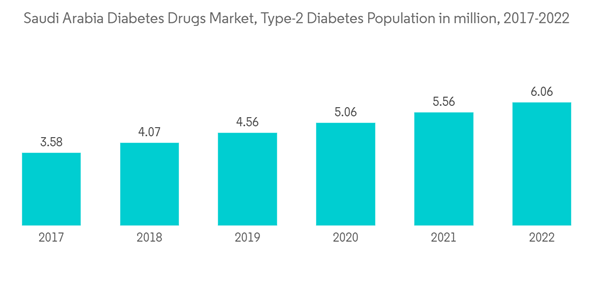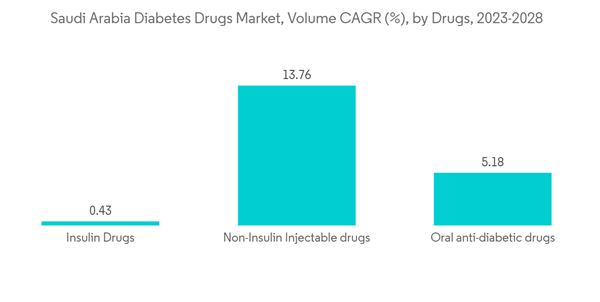The market is estimated to reach a value of more than USD 2.8 billion by 2027.
The COVID-19 pandemic positively impacted the Diabetes Drugs market growth in Saudi Arabia. Patients with diabetes, infected with COVID-19 may experience elevated blood glucose, abnormal glucose variability, and diabetic complications. The prevalence of diabetes in people with COVID-19 caused a significant increase in severity and mortality of COVID-19 in people with either type 1 (T1DM) or type 2 diabetes mellitus (T2DM), especially in association with poor glycemic control. While new-onset hyperglycemia and new-onset diabetes (both T1DM and T2DM) have been increasingly recognized in the context of COVID-19 and have been associated with worse outcomes. To avoid aggravation, a patient's blood glucose should be monitored and managed regularly.
Diabetic drugs are medicines developed to stabilize and control blood glucose levels amongst people with diabetes. Diabetic drugs are commonly used to manage diabetes. Diabetic drugs have been potential candidates for treating diabetic patients affected by SARS-CoV-2 infection during the COVID-19 pandemic. According to a study in Saudi Arabia, compliance with diabetes medication significantly increased during the lockdown, as the percentage of children who did not miss a dose of medications increased to 92.7%, compared to 70.7% before the COVID-19 lockdown.
More than one in ten people in Saudi Arabia are now living with diabetes and the prevalence of the disease will almost double by 2045, according to the report by the International Diabetes Federation (IDF). The IDF report mentioned that 4.27 million people in Saudi Arabia - which has a population of about 34.8 million have diabetes, while a further 1.86 million people have the disease but are yet to be diagnosed. This figure will increase to 5.6 million by 2030 and further to 7.5 million by 2045. Due to the early age and longer diabetes duration, the youth is at risk of developing diabetes at a younger age, which lessens their quality of life, shortens life expectancy, and increases healthcare costs to society.
Saudi Arabia is aiming to reduce the prevalence of diabetes by 10% over the next decade. Several initiatives, including taxing sugary drinks, fitness programs, and focusing on preventative care, are being taken by the government to stem this epidemic. The government's focus on combating diabetes and the higher purchasing power of the people in the country may help the market for diabetes drugs during the forecast period.
Saudi Arabia Diabetes Drugs Market Trends
The oral anti-diabetic drugs segment holds the highest market share in the Saudi Arabia Diabetes Drugs Market in the current year
The oral anti-diabetic drugs segment holds the highest market share of about 78.4% in the Saudi Arabia Diabetes Drugs Market in the current year.Oral Anti-Diabetic Drugs are available internationally and are recommended for use when escalation of treatment for type 2 diabetes is required along with lifestyle management. Oral agents are typically the first medications used in treating type 2 diabetes due to their wide range of efficacy, safety, and mechanisms of action. Anti-diabetic drugs help diabetes patients control their condition and lower the risk of diabetes complications. People with diabetes may need to take anti-diabetic drugs for their whole lives to control their blood glucose levels and avoid hypoglycemia and hyperglycemia. Oral anti-diabetic agents present the advantages of easier management and lower cost. So they became an attractive alternative to insulin with better acceptance, which enhances adherence to the treatment.
Diabetes is one of the largest health problems in Saudi Arabia. This country is ranked among the top 10 countries in the world concerning the prevalence of diabetes. Obesity, especially central obesity and increased visceral fat due to physical inactivity, and the consumption of high-calorie, high-fat, and high-sugar foods are the major contributing factors to diabetes. The most prominent work culture perpetuated in the country, which includes sitting for hours in one position and consuming fast food with little to no physical activity, is a significant contributor to diabetes in the working-age group.
The prevalence of diabetes is growing among all ages in Saudi Arabia, which can be attributed to the increasingly obese population, an unhealthy diet, and a sedentary lifestyle. When diabetes is undetected or inadequately treated, people with diabetes are at risk of serious and life-threatening complications, such as heart attack, stroke, kidney failure, blindness, and lower-limb amputation. These result in reduced quality of life and higher healthcare costs, leading to a greater need for access to care. The rising prevalence of diabetes and obesity, growing awareness of diabetic care, healthcare expenditure, and technological advancements are a few factors that are further driving the market.
Sulfonylureas segment is expected to register highest CAGR in the Saudi Arabia Diabetes Drugs Market over the forecast period
The Sulfonylureas segment is expected to register the highest CAGR of about 15.6% in the Saudi Arabia Diabetes Drugs Market over the forecast period.Sulfonylurea is an oral anti-diabetic drug used to treat type 2 diabetes. People with type 2 diabetes include chronically high blood sugar levels, and sulfonylureas make the body free up more insulin. Sulfonylurea compounds are the second preferred drug to treat Type 2 Diabetes. They are the most used agents due to their lower cost and as a mono-dosing. According to their discovery, these compounds are 1st, 2nd, and 3rd generations and are available for use as Chlorpropamide, Glimepiride, Glipizide, Glyburide, Tolazamide, and Tolbutamide. They function by increasing insulin secretion from pancreatic beta cells.
Saudi Government, in July 2022, announced that Saudi Arabia saw a growing demand for quality healthcare services spurred by changes, including an increasing and aging population and a growing prevalence of lifestyle diseases such as diabetes and obesity. The government and private sector are involved in working on healthcare entities, certifications, and regulations. The government is taking steps to include 100% of Saudi citizens covered by insurance and is working towards ensuring affordability, access, and quality digital healthcare and primary care with cost-effectiveness.
The World Health Assembly Resolution 2022 recommends the integration of prevention and treatment of diabetes into primary health services, developing pathways for a substantial increase in access to insulin, promoting convergence and harmonizing regulatory requirements for diabetes medicines and technologies, and improving diabetes monitoring and surveillance. Furthermore, it involves the WHO advising the Member States to ensure the uninterrupted treatment of people living with diabetes in humanitarian emergencies. This important milestone provides a global mandate for diabetes efforts for the next decade. The WHO Global Diabetes Compact focuses on reducing obesity and emphasizes improving access to affordable health services and medicines for early diagnosis and treatment of diabetes. Such initiatives are expected to create awareness among the people regarding monitoring and controlling diabetes, thereby enhancing the market prospects in the coming years.
Saudi Arabia Diabetes Drugs Industry Overview
The Saudi Arabia Diabetes Drugs Market is moderately consolidated, with major manufacturers, namely Eli Lilly, Sanofi, Novo Nordisk, AstraZeneca, and other generic players, holding a presence in the region. A major share of the market is held by manufacturers concomitant with strategy-based M&A operations and constantly entering the market to generate new revenue streams and boost existing ones.Additional Benefits:
- The market estimate (ME) sheet in Excel format
- 3 months of analyst support
This product will be delivered within 2 business days.
Table of Contents
Companies Mentioned (Partial List)
A selection of companies mentioned in this report includes, but is not limited to:
- Novo Nordisk A/S
- Takeda
- Pfizer
- Eli Lilly
- Janssen Pharmaceuticals
- Astellas
- Boehringer Ingelheim
- Merck and Co.
- AstraZeneca
- Julphar
- Bristol Myers Squibb
- Novartis
- Sanofi Aventis










